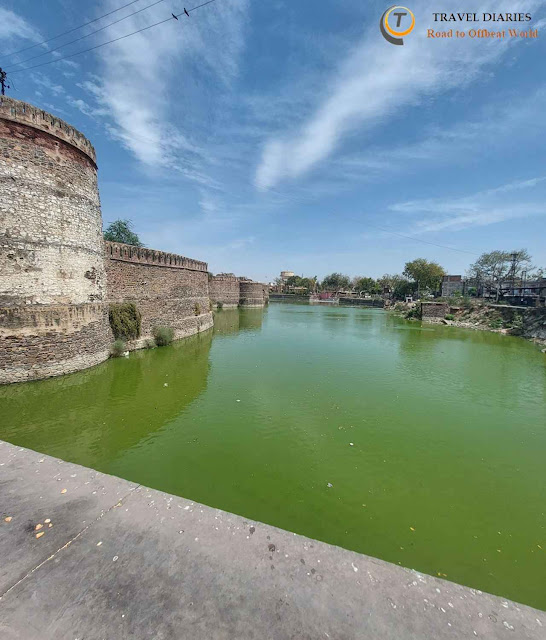While travelling to Agra as a kid, I often used to see the buses plying to/from Lohagarh
Depot on the highway. I used to wonder about the name Lohagarh and where Lohagarh was, as I was
unable to locate it on my school Atlas. Gradually I forgot about Lohagarh name, till one fine day I got to
know that Bharatpur Fort is known as Lohagarh, literally meaning Iron Fort.
Yes, Lohagarh is one of the strongest forts ever built in India and despite numerous assaults
from invaders and British, the fort remained unconquered. There will be no other way to feel the aura of this Fort, than standing in front of the gate.
Lohagarh justifies its
name through its architecture that focuses on strength and resilience over
ornamental stuffs like many forts in other parts of country. Lohagarh is a proud
testimony to strategic brilliance of Jat rulers, particularly Maharaja
Suraj Mal, who built the fort in 1733. The fort is surrounded by deep trenches
filled with water, which were earlier infested with crocodiles to
provide first line of defense against adversaries. The fort was constructed with thick outer walls
of mud instead of stone. This appeared crazy initially but proved highly
effective in absorbing fired canon from the enemies. Bharatpur army used to
retrieve the fired canons by the enemies from the mud walls and fire back the same canons on to the invaders/
attacking forces. Despite a prolonged assault, the British were unable to
breach the fort, suffering heavy casualties and ultimately retreating in 1805. Maharaja Suraj Mal fought around 80 wars and remained undefeated. Tales of his bravery are fondly
told till date at every corner of Bharatpur.
At one of the highest points in the Fort, a giant canon salutes
God Hanuman, and place is known as “तोप वाले हनुमानजी”, God Hanuman with a Canon.
This giant canon must have scared the hell out of enemies in those days.
1st spot on the
itinerary is Government Museum which is situated in the heart of Lohagarh which was established in 1944 under reign of Maharaja Sawai Brijendra Singh. The museum is a treasure trove exhibiting an impressive collection of artifacts
from erstwhile royal family of Bharatpur. Musuem is divided into Kachahri Kalan, Kamara Khas,
Haman (Persian Bath), Cahaman Bagichi, Chappan Khamba and Baradari. Keep on
exploring and keep on clicking.
Chappan Khamba is an
intricate 56 pillared structure open from all sides at terrace of the museum.
Opposite to Chappan Khamba is the Baradari, a structure with 12 entrances. The museum is also a home to number of statues which are being discovered at various places around Bharatpur. Check out spell-binding stone craft depicting Dhola-Maru folk tale, Nar-Varah (Human Boar), Goddess Kali killing demon Mahishasur, Putna killing by baby Krishna, dancing Shiva and an ornate pillar.
At a walking distance from museum, Jawahar Burj stands as a symbol of aura and strength. At first glance it looked like an architecture puzzle which must have been made to target incoming attackers in case they were able to reach till this point. It was
constructed as a watch tower to keep an eye over approaching enemies by
Maharaja Suraj Mal. Subsequently structures were added by Jawahar Singh to
commemorate his victory over Mughal rulers of Delhi and so got the name “Jawahar
Burj”. Intrinsically carved Barahdwari (12 door monument) is an attractive
spot.
An Iron pillar depicting ancestry of Bharatpur royal family was erected
by Maharaja Brijendra Singh. Burj gives an epic 360-degree view of Bharatpur
including canal surrounding Lohagarh.
Fort’s inner structures
were equally fortified for warfare rather than aesthetics. However, Lohagarh
house some palaces like Kishori Mahal, Mahal Khas, and Kothi Khas. Check out
Kishori Mahal –
Kishori Mahal earlier was
residence of Queen Kishori; wife of Maharaja Suraj Mal. Building now houses paintings
depicting events from life of Maharaja Suraj Mal. Maharaja Suraj Mal of Bharatpur was epitome of Bravery, Strategy and a Nationalist who successfully repelled invaders and safeguarded regions of Mathura, Aligarh, Agra till Rewari and established Bharatpur as a powerful state in northern India. Suraj Mal shifted the capital to Bharatpur in 1730 from Deeg as Lohagarh was nearing completion and Deeg was coming under repeated attacks from mughal rulers of Delhi. In front of Kishori Mahal statue of Maharaja Suraj Mal displays same elegance and authority that distinguished him during his reign. Despite being
a powerful king, he was a paragon of simplicity as well wearing local dresses
and speaking language of people. Few lines in his honour, drawn from the Bharatpur
folk tales -
लोहागढ़ के
वीर पुरोधाओं की गाथा गाता हूँ, महाराजा सूरजमल से वीरों की याद दिलाता हूँ
अमर प्रेम था देशभक्ति का जिनके सिर चढ़कर बोला, माटी की रक्षा की
खातिर जिनका खून हमेशा था खौला
चेहरे पर जिसके ओज हमेशा सूर्योदय सा चमक गया, अफगानी आक्रांता
अब्दाली जिसका खत पढ़कर ही धमक गया
राजनीति और कूटनीति के बेहद अपार वह ज्ञानी थे, अंग्रेज-मुगल-अफगानी
जिसके आगे भरते पानी थे;
भारत माता का वीर पुत्र वह हिंदू धर्म का रक्षक था, सत्यप्रिय,था न्यायप्रिय, अन्यायी दानव का
भक्षक था
वही वीरता,
वही सुशासन,
कूटनीति रग-रग में थी, देखो यश गाथा आज भरतपुर की फैली सारे जग
में थी
ना कभी झुका है ये ना कभी झुकेगा, ये हिन्दू का सिर है गर्व से उठेगा
फक्र है हमें सूरजमल के संस्कारों पे, भगवा ना झुका है भगवा ना झुकेगा...।।
To summarize – At Lohagarh,
ancient walls breathe secrets of the past and invites history lovers to immerse
themselves for a day and there are some unique temples like Lakshman Temple
which is one of its kind in the World and Ganga Temple.
Keep exploring folks...














